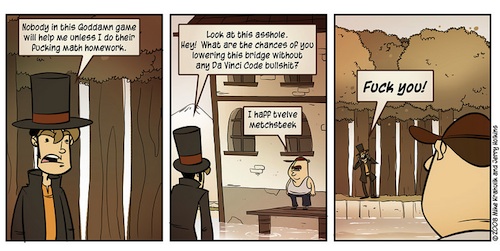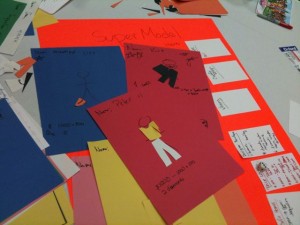One of the rules I try to follow on this blog and on Twitter is to not talk about prerelease information for video games. (And, indeed, I don’t even follow prerelease information for video games too closely—why would I want to spend my time thinking about games that don’t yet exist in preference to games that I could actually play?) But, occasionally, a piece of news comes by that makes me sit up and take notice; and I’m enough of a Harmonix fanboy that the recent Rock Band 3 information hit me in my sweet spot. (Incidentally, Plastic Axe is the best source of Rock Band 3 information that I’ve found.)
What continues to impress me is the scope of the vision that the company has. They are not just trying to make a game that’s a lot of fun: they are trying to fundamentally alter humanity’s relationship with an art form that is older than recorded history, and to do so in an unalloyed positive fashion.
Guitar Hero, of course, kicked this off. It was mostly just a fun video game (though one with far reaching effects in the industry beyond video games, in its revitalization of alternate control interfaces), but it also tried to drag our interactions with music out of the relatively passive listening context, adding in some amount of interactivity. I don’t want to overstate the novelty of this—people sing along and play air guitar and drum along to music all the time, and there are karaoke games out there as well (though I haven’t done my research well enough to know how their dates compare to Guitar Hero‘s), but doing this in an instrumental game context was important and struck a chord.
I never played Guitar Hero 2, so I don’t have a good feel for how transformative its addition of bass was. My guess was that it wasn’t too transformative—bass and guitar isn’t all that compelling a fantasy context (though, having written that, I’ll have to admit that Liesl and I have a great time doing just that), and of course the mechanics of playing the two are very similar.
But I did play Rock Band, and the jump from Guitar Hero to that game was huge. Playing a full band is a compelling difference from just playing a guitar: it makes it a much much more social experience, and there are a lot of people who are naturally drawn to vocals or drums who wouldn’t be drawn to fake plastic guitar.
And that wasn’t the game’s only key advance: downloadable songs began to appear right after release, and they’ve come in a steady flow every week ever since. Harmonix’s support for DLC is in sharp contrast with almost every other gaming company out there, and it made it clear that they see Rock Band as a platform, not just a game, and one which they want to actively curate. And the steady flow of DLC began to raise the question: why aren’t all songs available this way? I mean, I know the practical reasons why that’s currently the case, but surely that’s a bug, not a feature? So what has to happen to fix that bug?
Next came Rock Band 2, which was an incremental improvement, albeit a solid one. It tweaked the social aspects, and its support for not only DLC for the original Rock Band but the ability to import Rock Band songs made it clear that Harmonix was serious about their platform vision.
And, a year later, we had The Beatles: Rock Band. Again, not a major advance (though vocal harmonies are surprisingly powerful), but I really appreciated the lovingly curatorial approach that the game showed. These games are altering our interactions with one of the most ancient of art forms; as such, they should treat music with love, care, and respect, and The Beatles: Rock Band very much did so. (Incidentally, that curatorial approach is another another strength of the band approach over Guitar Hero‘s single instrument: I got a lot more appreciation for the different musical parts once I was able to isolate them and concentrate on each one individually.)
So, at this stage, what are the major issues remaining, what are the next steps? The first issue is the bug I mentioned above, that not all music is available for Rock Band. The folks at Harmonix are great, and they’re putting out an unprecedented amount of DLC (I just had my 360 red ring, and when looking through the list of DLC when deciding what to re-authorize, a good 80 to 90 percent of it must have been Rock Band songs), but even so they’re clearly a bottleneck here. The solution to that, of course, is Rock Band Network; in the long run (and even the medium run) I expect that to be one of the most important video game developments from 2009.
And then there’s another variant of that problem: there does, in fact, exist music that is written for ensembles other than guitar, bass, drums, and vocals. This is, obviously, a quite open-ended problem (witness the Accordion Hero and Sousaphone Hero parodies), and it will take a long time to solve, but as a piano player, I would like to have keyboard support.
Finally, there’s the complaint that pressing colored buttons and hitting the strum bar isn’t very much like playing guitar. I don’t see this as an active problem (and I also note when it comes up that that isn’t the case for the new instruments in Rock Band), but it’s clearly an area where one can imagine improvement.
Which brings us to Rock Band 3. It attacks those two problems head on: I’ve been asking Harmonix employees in my twitter feed for keyboard support for a couple of years now, and not only do I have it, I have a couple of octaves of keyboard support, which is about as good as I can imagine right now! (And talking to people about Rock Band 3 over the last day or two, I’m not the only person out there who would like to put their piano lessons to use.) And they took the most unrealistic instrument, and completely overturned that: now, if you wish, you will be able to play Rock Band 3 on an honest to goodness electric guitar with full fingering charts. (They made incremental improvements on the realism of drums as well, but of course not as much improvement was needed there.)
And I’m looking forward to this more than any other video game news in ages. I’ll get a keyboard controller on launch, and dive into the deep end and see how well I can swim. I imagine that I’ll eventually dabble with pro mode on the guitar, too: I’m a reasonably good guitar player on Rock Band, and I think I’d get a lot more out of bumping up the realism on easy songs than from trying to master the most difficult songs on the current expert setting. I doubt I’ll dive into drums in the same way, though: I’m a much worse drum player, not even able to finish all drum songs on hard, and I imagine that I’ll be able to sink arbitrarily large amounts of time into guitar should I so choose. Which is actually another question that I’m wondering: just how much of my video game playing time is this game going to absorb in the year after it gets released?
So: what should we expect next from Harmonix? I imagine that there are enough big changes in Rock Band 3 that Rock Band 4 will end up being an incremental improvement similar to Rock Band 2; after that, though?
The above narrative points out two obvious areas for improvement. Harmonix has removed themselves as a major bottleneck for music availability, but while we’re getting a lot more content off of Rock Band Network than we could get before, there’s still a further flood of music out there that I want unleashed on the world; I’m not sure exactly what the next step is to enable further growth, but I am sure that next steps are out there. And the other is that we’ve gone from one instrument type (plus a minor variant) to three to four; we’re not done yet, and at some point we’re going to make a jump to “many”. Again, I don’t quite understand how that is going to happen (though a deep partnership with an external manufacturer, as they’ve done, is a good first step), but happen it should.
The other area of improvement that I’d like to see is for Harmonix to get platform independence. I’m now on my third Xbox 360; and even if that hardware weren’t seriously flawed, console lifecycles are only so long (though this one will be longer than normal, mercifully), and at this stage I fully expect to care much more about my musical investment than about the actual games for the console. To some extent, I’m resigned to losing most of that investment, but this is a problem that Harmonix (or somebody!) needs to solve eventually: we need to be able to move gamified songs from platform to platform the way we can move mp3s from platform to platform.
To that end, the most relevant parts of the recent announcements are the fact that all the new instruments have MIDI output ports, and that most of the existing DLC already contains symbol markings for use with the new drum kit. The point here is that this isn’t a brand new problem that Harmonix needs to solve. What we want is a way of representing music that is good enough to support learning to play it on real instruments (at least to the extent of telling if you’re basically playing the right notes at the right time), that is capable of degrading gracefully (as seen in the drum example above; I wonder whether Harmonix is already scoring keyboard parts in such a way that, eventually, we’ll be able to use Rock Band 3 and later content with an 88-key piano?), and that supports future instrument choices. And we need a platform-independent and more-or-less instrument-independent output format that can be matched up against said musical representation.
This, of course, isn’t rocket science: we’ve had perfectly suitable musical notation formats for hundreds of years now, and MIDI is (I assume, I’ve never looked into it) probably something that can do just fine on the output format representation. Also, the nice thing about this is that it gives a proof of concept that there is actually a natural stopping place to the feature creep here: we have known solutions that are sufficient to allow us to represent almost any piece of music in existence in a gamified format, which is what’s really important here. Heck, for all I know, their planned MIDI controller will already let us have most of that ability for free!
So, what’s the next big step? I don’t know for sure, of course, but it seems to me that the natural path forward is as follows (possible simultaneously, possibly in some order):
- Harmonix generalizes their music representation format to support arbitrary instruments, with whatever changes are necessary to support that in their authoring tools.
- Harmonix makes a full version of Rock Band available on a non-console platform, or probably on multiple non-console platforms. (I’m sure they’ve thought about launching their own dedicated device, but I don’t think this is particularly likely—they’re already moving away from hardware vertical integration, and I don’t think that a console would be enough of a match to their current strengths to help them more than it would hurt.)
- Harmonix opens their own game music store (think “iTunes store for Rock Band“, and eventually for all music), offering long-term persistence and portability of the music that you purchase through it.
- Harmonix, MTV, peripheral manufacturers, and actual sane forward-thinking record company executives all work together to make this a huge success, supplanting mp3s as the default format for music purchases going forward.
That last one is a bit of a stretch: sane, forward-thinking record company executives? And, of course, there are good reasons for record company executives to not want to give somebody too much exclusive control over key areas of their business. Certainly I would prefer to live in a world where this developed as an open standard that companies could freely share in; and quite possibly that’s the way that this will turn out. (Though, as is obvious, I’m enough of a Harmonix fanboy to be willing to give them a chance at being our benevolent musical overlords, at least in the short-to-medium term.)
But happen it will. Maybe I’m drinking too much of my own kool-aid, maybe being at GLS is causing me to see the potential for games everywhere. But really, how could it not happen? Having music come embedded with its own score is both obviously good and completely technologically feasible; using that embedded score for ludic and didactic purposes (and really, aren’t those one and the same in this instance?) is equally obviously good; and we are at the dawn of a golden age of gaming that makes this sort of transformation inevitable.




 Posts
Posts